Abstract
This study investigates the impact of a thermal power plant site on air quality in Bucharest, Romania. It emphasizes the importance of accurate air pollutant inmission measurements in urban areas by utilizing mobile measurements of low-cost sensors, Copernicus’ Copernicus Atmosphere Monitoring Service (CAMS) and Copernicus Land Monitoring Service (CLMS), and satellite retrieval to better understand climate change drivers and their potential impact on near- surface concentrations and column densities of , CO, and PM (particulate matter). It focuses the attention on the need of considering the placement of power plants in relation to metropolitan areas while making this assessment. The research highlights the limits of typical mesoscale air quality models in effectively capturing pollution dispersion and distribution using LUR (Land Use Regressions) retrievals. The authors investigate a variety of ways to better understand air pollution in metropolitan areas, including satellite observations, mobile measurements, and land use regression models. The study focuses largely on Bucharest, the capital of Romania, which has air pollution issues caused by vehicle traffic, industrial activity, heating systems, and power plants. The results indicate how the placement of a power plant may affects air quality in the nearby residential areas.
1. Introduction
A crucial responsibility of the scientific community in addressing the drivers of climate change and the impact of air quality on human health is to accurately measure the emissions of gaseous and particle pollutants in metropolitan areas, considering both the influence of human activities and natural factors, and considering the specific geographical and temporal scales relevant to these places. At the European level, the European Green Deal policy aims to significantly reduce air pollution and improve air quality by implementing stricter emission standards, promoting clean energy sources, and encouraging sustainable transportation [1,2]. On a global scale, strategies and policies are actively enforced to better control pollution [3,4,5].
Enhanced quantification is necessary because conventional mesoscale air quality models can accurately replicate general air quality conditions in urban areas, but lack the ability to accurately determine the distribution, dispersion and source distribution of air pollutants at street level resolution [6,7]. In general, state-of-the-art literature shows encouraging findings on the reduction of air pollution in Europe, while also highlighting areas where further research and emission control efforts are needed. To better understand the dynamics and dispersion of urban emissions, it is vital to incorporate state-of-the-art models that augment conventional mesoscale air quality and climate models, including conventional computational fluid dynamics (CFD) methods and machine learning techniques, supplemented by measurements obtained near individual pollutant sources [8,9].
1.1. Methodologies for Resolving Air Pollution in Urban Areas
The European Union (EU) CAMS has the ability to distinguish suburbs from the main cities in Europe, but they are unable to accurately represent the intense variations inside the cities that are influenced by the road networks and industrial operations [10]. Monitoring stations located near major roadways-provide significantly higher measurements compared to the averaged values of the 0.1 × 0.1 degree latitude-longitude grid-box model. Downscaling CAMS products based on existing emission inventories is possible, however, has limitations. For example, studies performed in Barcelona [11,12] and Paris [13,14], showed that inaccurate emission inventories introduce significant uncertainties in the estimation of pollutants concentration at street level, especially Elemental/Organic Carbon (EC/OC) and concentrations, traffic being one particular issue.
The use of satellite observations is gaining increasing interest, particularly in the EU CAMS Evolution (CAMEO) development project, where efforts are being made to include tropospheric column densities satellite data from TROPOMI onboard Sentinel-5 Precursor into the project’s assimilation process [15,16]. TROPOMI is a passive instrument which has a distinct resolution of 3.5 × at its nadir point for the VIS sensors, which is less than the grid cell size of the regional models. TROPOMI has a daily flyover at around 13:30 UTC in the mid latitude northern hemisphere, when it crosses the equator which makes it feasible for air quality studies. However, with the coarse spatial resolution and the limitations of the retrieval algorithms to separate at the surface from the total column, this data also cannot resolve air pollution inside the cities. In the future, once the geostationary Sentinel-4 and the low Earth orbit Sentinel 5 are launched, it will provide hourly observations during daylight hours over Europe and globally, using both Sentinel 5 and Sentinel 5-P, expanding its observation capabilities [17].
The impact of pollutants from power generation on air quality and human health effects have been intensively studied in the last decades all over the world, particularly for small particles and [18,19,20]. Conducting model downscale operations, as demonstrated in this work, is an additional approach to accurately depict the local variations in cities. This method enables more relevant comparisons with the data collected from ground stations.
Various methodologies can be employed to generate detailed outdoor exposure maps of health-related pollutants in urban areas. These methodologies include the utilisation of modeling tools, mobile measurements of nanoparticles, BC and particulate matter (PM) mid-cost sensors, novel dispersion measurements, and the involvement of citizen networks and innovative instruments [21]. Chemical transport models are commonly used to simulate urban background concentrations in cities [22]. However, these models generally have horizontal resolutions that are coarser than 1 × . At this resolution it is difficult to accurately reflect the heterogeneity inside the city. Along traffic axes and streets, pollutants like nitrogen dioxide (), black carbon (BC), , and , and the Fine Mode Fraction (FMF) defined as the ratio between and exhibit significant variability. The extent of these variations can be influenced by the season [23] and to capture them accurately, a high-resolution may be necessary.
Typically, there are two primary methods employed to depict these variations: (a) Deterministic models employing a multi-scale and multi-pollutant approach, including , , , BC, and particle number concentrations [24]; (b) Examination of mobile monitoring and/or citizen observations through the utilisation of LUR modeling to create maps of Number, , , and concentrations [25,26,27]. The simulated concentrations are compared to the measurements from regular monitoring, if feasible. Challenges arise due to the limited availability of monitoring data, particularly for pollutants that are not subject to regulation [28]. It is advantageous to constrain the models at several types of stations that represent diverse characteristics of metropolitan regions, such as traffic, urban background, and suburban areas. When conducting investigations utilising LUR modeling, it is only appropriate to compare the spatial average modeled concentration with the actual measured data [28]. When using the deterministic modeling, more comprehensive statistical analyses of comparisons are conducted, as daily concentrations are explicitly estimated [29]. Usually, to assess the variability of air pollution in urban areas, concentrations are mapped during both winter and summer seasons, and the variations in concentrations between these two -seasons are compared.
1.2. Focus of the Study
Bucharest, the capital of Romania, is in the country’s southern region, in the Romanian Plain. It has a population of approximately 2.1 million in 2022 and 2.5 million in the metropolitan area [30], being Romania’s largest city as well as its cultural, economic, and political hub. Bucharest spans and has a population density of more than 9000 persons per . It boasts a complex metropolitan landscape with a mix of land uses, including industrial, commercial, and residential districts. Particulate matter pollution in Bucharest is mostly caused by road travel, industrial and manufacturing processes, heating systems, building and public works, agriculture, waste incinerators, commercial and service activities (e.g., [31]). Road travel is one of the most prominent sources of fine particle emissions in Bucharest, primarily from cars powered by fossil fuels, Bucharest being ranked eighth in the world for traffic congestion [32]. In 2022, Bucharest had an automobile fleet of more than 1.5M vehicles, of which passenger were cars accounting for 80% and 59% were older than ten years [33].
Industry and industrial activities are another significant cause of pollution. According to Risk Management at the National Environmental Protection Agency [34], Bucharest has 29 significant polluting enterprises, three landfills, one of which is still operational, and two water treatment plants. According to Bucharest City Hall, there are now 394 residential building sites, 15 industrial, 248 commercial, 134 communal, 38 scientific/medical, 32 utility, and 80 infrastructure projects in Bucharest [35,36].
During the cold season, heating systems, particularly those powered by fossil fuels or wood, emit particles into the atmosphere [37,38]. Central heating with natural gas or solid fuel is widely used in Bucharest [39]. Among the several causes of particulate matter pollution in Bucharest, the power plants are major contributors, with CET Vest, one of the city’s main thermal power plants, supplying a significant amount of Bucharest’s energy and heat needs.
The CET Vest power plant, a crucial energy source for Bucharest, has been in service since 1972, serving as a cornerstone of the city’s power infrastructure. With an installed electrical power capacity of 436.25 MW and a massive thermal power output of 1196 Gcal/h [40]. CET Vest is equipped with five steam turbines capable of generating 310 MW, guaranteeing a stable supply of power to the region’s households, companies, and industries. It operates on a flexible fuel system and may run effectively on natural gas or fuel oil. CET Vest boasts an impressive 180-metre-high chimney. In 2020, the factory underwent extensive refurbishment, using new automation technologies to improve operating efficiency and sustainability. Despite modernization efforts, it remains one of Bucharest’s major industrial pollutants, ranking as the third-largest emitter of particulate matter (PM), nitrogen oxides (NOx), and carbon monoxide (CO) among energy suppliers, as well as emitter of carbon dioxide ().
The goal of our research is to assess the influence of the power plant on air pollution in its proximity, namely in the residential area north of the CET Vest. Population exposure due to power plant emissions is a major concern in the surrounding residential areas. More particular, we assessed particulate matter and levels near the power plant during peak emission periods and less intensive heat producing capacity throughout the summer, and compared the results to those obtained at a reference location.
2. Methodology
Our research employed a combination of near-surface observations, satellite data, and the latest European reanalysis data set of atmospheric composition (AC) produced by the CAMS to evaluate the impact of the CET Vest power plant on the air quality. The analysis focused on a residential area northeast of the designated hotspot, aiming to assess the plant’s influence on the local air environment.
2.1. Observations
Two measurement procedures were used: (a) stationary observations at two locations, one near CET Vest and one at a peri-urban multi-instrument super-site (MARS) that served as a reference; and (b) mobile measurements along a designated path to be fed paired with a LUR model for fine mapping. These measurements were complemented with satellite observation from TROPOMI and CAMS air quality reanalysis data [41].
2.1.1. Observations at Fixed Locations
A provisional surveillance station was set up in close proximity to the CET Vest power facility. Particulate matter was measured at a stationary site throughout the period of May to August 2022. Simultaneously and using similar equipment, measurements were conducted at the permanent reference site (MARS), located roughly 10 km southwest of the region of interest (Figure 1, left panel). The objective of this phase of the research was to assess and contrast the atmospheric conditions in the residential vicinity adjacent to the CET Vest power station (located in the Militari district) with those in a comparable residential region unaffected by any power plant (located in Magurele). It is important to acknowledge that both sites are influenced by additional sources of particulate matter and , such as traffic and industry. As a result, neither region can be classified as a background site. Nevertheless, doing measurements at specific sites enabled us to utilise more advanced instruments that provide superior stability and precision. Additionally, we were able to implement all essential quality assurance procedures directly on site.
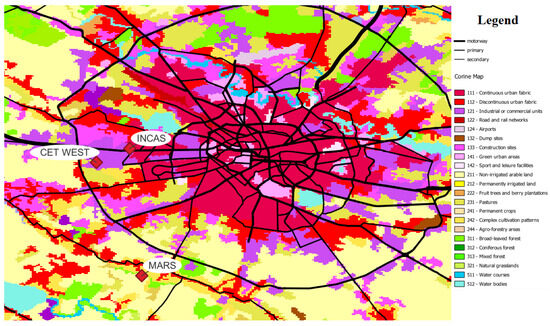
Figure 1.
CORINE map of Bucharest and main roads.
MARS (Magurele centre for Atmosphere and Radiation Studies) is one of the two observation sites of the RADO-Bucharest National Facility, contributing with observations on atmospheric composition to the ACTRIS data portal, as well as to other European and global databases (e.g., E-PROFILE, PGN, BSRN, etc.). RADO-Bucharest is a regional WMO-GAW station situated in a peri-urban region, in the southwestern outskirts of Bucharest (44.348° N, 26.028° E, 93 m above sea level). Indoor and outdoor laboratories are hosted in 2 neighbouring locations (1.8 km apart), with MARS (44. N, 26. E, 77 m above sea level) hosting most of the outdoor operating instruments. MARS laboratories use ACTRIS-compliant and auxiliary equipment to measure in a standardised and quality assured way the properties of aerosols near-surface and in the tropospheric layers, and clouds, trace and greenhouse gases. For the purpose of this study, all instruments deployed at the temporary site, and those used for mobile measurements have been validated and calibrated against the quality assured equipment at MARS. The optical particle counter EDM180 Grimm provided the reference for the particulate matter measurements, following the EN EN12341 and EN17660 standards [42,43,44].
The temporary site at INCAS (44. N, 26. E, 98 m above sea level) was located in the urban area of Bucharest, in close proximity to a heavy traffic zone and the CET Vest power plant. Figure 1 displays the geographical positions of MARS, INCAS, and CET Vest, together with the land use data obtained from CORINE Land Cover (Coordination of Information on the Environment) and the main roadways inside the city. Additionally, the nearby metropolitan area located to the North and East has an impact on the measurements taken at the location at ground level. Since May 2022, a variety of instruments, comparable to those used for monitoring at MARS, have been installed at this location. The suite of instruments included a ceilometer, wind lidar, gas monitors, and an optical particle counter (the AQMesh sensor from Environmental devices monitors). The INCAS temporary site is located approximately 2.6 km away from the chosen hotspot, with no significant barriers obstructing the line of sight between the site and the power plant. The region exhibits industrial activity on its southern and western sides, while its northern and eastern sides are predominantly residential. The property is significantly impacted by the traffic, since it is located around 200 m from one of the busiest roads in Bucharest.
2.1.2. Mobile Observation
Mobile measurements of particulate matter and were conducted using inexpensive sensors in a highly populated residential neighbourhood near the hotspot, and in comparable parts of Bucharest city (Figure 2). Consistent data was gathered on a regular basis along a specific route throughout both the warm season (from May to August 2022) and the cold season (from January to February 2023). Portable devices were used to measure ultra-fine particles (UFP), and different fractions of particulate matter (i.e., , , ), and gaseous compound (i.e., ). For this investigation, we utilised data collected by Ecomesure EcomTrek (measured every 10 s). The low cost sensors have been succesfully used to map and assess the air quality in different European urban areas either by empirical and deterministic modeling [45]. Combining mobile measurements with mixed-effects LUR models proves highly effective for air quality mapping in Bucharest [46].
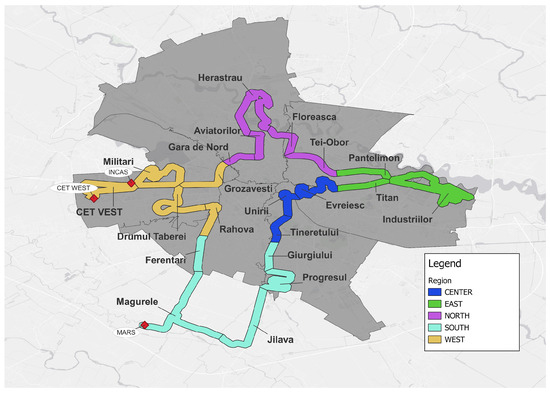
Figure 2.
Mobile measurements route throughout Bucharest and its districts.
The portable instruments measurements were compared with those from MARS before deploying them for the mobile. Time series of co-located in time and space observations of and are shown in Figure 3 and Figure 4. The results show good correlation between the two instruments, with the uncertainties higher on the portable EcomTrek instrument but within the limits specified by the manufacturer [47].
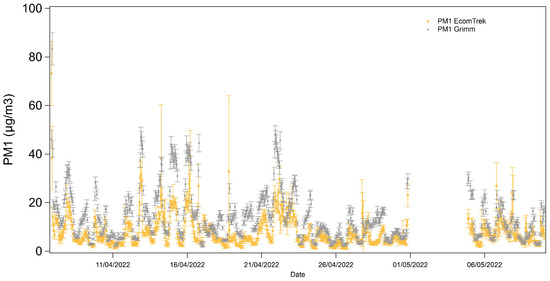
Figure 3.
GRIMM and EcomTrek co-located timeseries of .

Figure 4.
GRIMM and EcomTrek co-located timeseries of .
The chosen route was designed to traverse all significant districts of Bucharest (indicated by distinct colours in Figure 2) within a maximum of 8 h of driving at a speed limit of 30 km/h. It encompasses congested city roads, residential, industrial, and commercial zones, and suburban areas. The data have undergone filtration to eliminate any sudden and irregular fluctuations, retaining just the measures that exhibit a steady pattern. The main scope of it was not to include the very local emissions from traffic. The mobile measurement filtering used a moving average window with a size of 3 data points. Any concentrations that were more than 1.5 times higher or lower than the mean were eliminated.
In this study, data measured in different districts of Bucharest and surroundings have been analysed to evaluate the air quality. The objective was to determine whether the district where the CET Vest power plant is situated exhibits any distinctive characteristics in comparison to other districts. Additionally, we utilised a subset of this data in the Militari and CET Vest region to supply the LUR fine mapping model and examine the influence of the CET Vest power station on the adjacent residential area.
2.1.3. Satellite Observations and CAMS Europe Ensemble Dataset
In this study, we have also used satellite measurements from TROPOMI onboard Sentinel-5P to assess tropospheric [48] and total column CO densities [49] over the points of interest (INCAS and MARS sites). The data was initially filtered based on quality-assured (qa) variable values (considering pixels with qa values larger than 0.75 for and 0.5 for CO), followed by regridding to a regular 0.01 × 0.01 degree latitude-longitude grid. Finally, temporal averaging was performed for the duration of the study using the Atmosphere Virtual Lab’s (AVL) HARP library.
Additionally, CAMS air quality reanalyses ensemble data were also used to assess the atmospheric surface level state for , , , , and CO. The CAMS ensemble dataset is a global reanalysis product that provides daily estimates of atmospheric composition. It is produced by combining data from multiple weather forecast models and satellite observations, and is available for a variety of atmospheric constituents, including aerosols, trace gases, and meteorological parameters. In this study, we retrieved CAMS reanalysis data to assess the average season values and to compare it with the LUR model.
2.2. Land Regression Model
The model used for providing the fine mapping is based on the mixed model framework developed by [21] to generate high-resolution air quality (AQ) maps that predict concentrations through LUR models for Amsterdam and Copenhagen using large-scale mobile measurement campaigns [50]. This approach was adapted to develop consistent data sets consisting of maps of atmospheric pollutant concentrations with a resolution of 100 m, covering the entire area of the city of Bucharest, an area of approximately . The independent parameters used to build the specific LUR models for Bucharest were selected based on the supervised forward stepwise regression approach proposed within the European Study of Cohorts for Air Pollution Effects (ESCAPE) project [51]. The differences in correlation factors observed during the warm season could be attributed to the higher uncertainties attributed to the intensified photochemical processes at street level, which the current model may not accurately represent. More details about LUR models developed for Bucharest are found in [46]. Output maps provide average values of , , and . For performance evaluation and validation of the maps, independent measurements of air pollution from Romanian National Air Quality Monitoring Network (RNMCA) [52] stations and MARS were used.
The agreement between the measured data at the fixed stations and the data obtained from the model was quantified by calculating the R-squared () and root mean square error (RMSE). The results are presented in Table 1.

Table 1.
Performance of LUR models for estimating and concentrations for the cold season and the warm season, expressed in terms of the statistical parameters and RMSE.
In our specific study, we used two kinds of input data. For the warm season, as measurements were not available for CET Vest region, the retrieval relied only on maps with estimated pollutant distribution derived from LUR modeling with a horizontal resolution of 100 × obtained from the mobile measurement campaign conducted between May and July 2022.
To achieve a fine resolution of for CET Vest Bucharest area, the Random Forests (RF) method has been used for downscaling concentrations of the pollutants. This method has been proven effective in the spatial analysis of various air pollutants [53]. For the cold season the pollutant distribution maps were derived from the mixed-effect models fitted from the measurements taken during the winter campaign in the CET Vest region between January and February 2023. The downscaling and mixed-effect models were created in Python (version>=3.6) with dedicated machine learning tools: Scikit-Learn Downscaling and statsmodels modules. To ensure data consistency, the same predictors as during the summer season were used. The , , and FMF maps were created for both seasons at a horizontal resolution of 15 × .
3. Results and Discussion
3.1. Comparison Between Districts of Bucharest
Mobile measurements of , , , and have been performed on a track of approximately 100 km in length to be representative for the entire city, including also the residential area nearby the CET Vest and its surrounding area (Figure 2).
The mean values and their associated variability of each pollutant representative of several Bucharest districts during the warm and cold seasons are presented in Table 2.

Table 2.
Mean values and associated variability of PM1, PM2.5, PM10, and NO2 in several districts of Bucharest, as measured with mobile instruments during the warm season (May–July 2022) and cold season respectively (January–February 2023).
Table 2 shows the mean values and associated variability of , , , and for both warm and cold seasons for each of the districts as presented in Figure 2. Lowest and highest values for each season are highlighted in green and red respectively alongside the number of observation considered in the calculation as depicted in the “#Points” column. Due to limitations on precision and accuracy of the low-cost sensor mounted on the moving car, the results will be further analysed qualitatively rather than quantitatively. The findings indicate that during the cold season, particulate matter levels in every district rise by a factor of two or more, depending on the district, residential heating being clearly one important factor. Highest values of particulate matter are noted for both seasons in Ferentari district (South Bucharest). Measurements in the vicinity of CET Vest also present high concentrations, but not and . The lowest values of particulate matter are measured in Evreiesc district (Centre-East Bucharest) during the warm season, and Giurgiului (Centre-South Bucharest) during the cold season. concentrations are greater during the summer than they are during the winter, which is likely due to the slightly increased volume of traffic throughout the summer in combination with increased photochemistry (conversion of NO to in the presence of solar radiation and ). Nitrogen dioxide levels in the district where CET Vest is located are not higher than those in other districts during the summer months. However, during the cold season concentrations near CET Vest are among the highest in Bucharest, although the traffic in the area is much reduced, as have been observed in the traffic maps generated by Open Street Map [54]. Figure 5 presents the seasonal-mean near-surface concentrations of the fine mode fraction of particulate matter in different Bucharest regions as observed by mobile measurements.

Figure 5.
Seasonal-mean near-surface concentrations of PM fine mode fraction in different Bucharest regions as observed by mobile measurements: warm season (left panel); cold season (right panel).
One can note that during the cold season, the ratio between the and is higher than 0.5 in all Bucharest districts, indicating that small particles are predominant. Such particles can be associated with traffic, industrial activity or heating, the last one being the main source during winter. Although the western district shows no particularly larger values than other regions, it is worth noticing that the distribution of the values is skewed towards higher numbers, meaning that the predominance of small particles is observed more often. For other regions, the distribution has a bi-modal aspect, especially in the Center, meaning that the predominance of small particles is not constantly observed. During the warm season, the South and the West regions present a wide spread of the values, indicating that cases of predominance of small particles are alternating with cases when large particles are predominant. This is related to the land use in these regions, a mixture of residential, industrial and agriculture fields, which results in a mixture of small particles (from traffic and industry) and large particles (from agriculture and constructions). In the Centre and the North regions, small particles are constantly present during the summer, most likely due to traffic. The East region is also generally impacted by traffic and industry, however large particles from constructions are sometimes present, less frequent than in the case of South and West regions.
Figure 6 presents the seasonal-mean near-surface concentrations in different Bucharest regions.
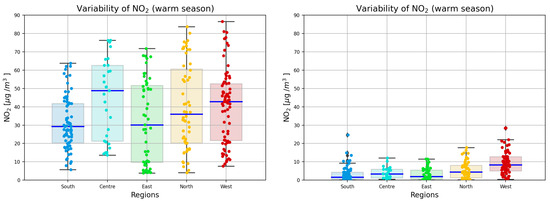
Figure 6.
Seasonal-mean near-surface concentrations of concentrations in different Bucharest regions as observed by mobile measurements: warm season (left panel); cold season (right panel).
The observed values are ten times higher during summer than winter, in all regions. However, one can note that the values are particularly higher during the warm season in the Centre and in the North regions, related to more intense traffic as indicated also by the fine mode fraction. Lowest values are observed in the South, and highly variable values are measured in the East. The West region where the power plant is located has no particularly high values during summer, although the mean value is the second highest after the Centre. During the cold season, however, the West region shows the highest concentrations which cannot be explained by more intense traffic than in other regions. It can only be explained by more intense activity of the CET West power plant, the larger industry in the area.
3.2. Comparison of the Study Area with Reference Site
Mobile measurements presented above have the great advantage of covering the whole Bucharest city and suburbs, therefore allowing comparisons between districts and regions. However, this data is measured using low-cost sensors which, even with regular calibration, do not have high precision, therefore the conclusions must be drawn with care. In addition, mobile measurements may be affected by instantaneous events that cannot be always identified and extracted as outliers. For the purpose of feeding the LUR model this data is acceptable since the model uses a combination of indicators to do the downscaling. In the following chapter we checked if the mobile measurements are consistent with the more accurate measurements at fixed locations.
3.2.1. Near-Surface Measurements
An analysis was conducted on aerosol near-surface data obtained between May and August 2022 using two optical particle counters. The purpose of the analysis was to identify air quality specific events characterised by higher mass concentrations of particulate matter, namely , , or . The European and national laws on air quality specify that the maximum allowed levels to be attained by 1 January 2030 for daily average concentrations of and , as well as the yearly average concentrations of and , are 45 μg/m3, 25 μg/m3, 20 μg/m3, and 10 μg/m3 respectively. These regulations are outlined in the Air Quality Directive 2884/2024/EC [55]. In our analysis, we refer to these limits.
Seasonal mean values of , , and measured at the two locations are presented in Table 3. The daily levels exhibit comparable fluctuations and highlight the occurrence of elevated concentrations in the warm season, with higher values in Magurele (MARS) for . Throughout the whole period, the temporary site in Bucharest (INCAS) is primarily dominated by small particles, whereas the MARS location is primarily dominated by large particles, while concentrations of are similar.

Table 3.
Mean values and associated variabilities of near-surface , and measured at MARS and INCAS fixed observation sites.
The variability of , , and daily averages at INCAS and MARS during the warm season is presented in Figure 7. The left panel shows the absolute values (mean, standard deviation and spread of the values). One can note that presents higher mass concentrations at INCAS, its variability being more pronounced than in the case of concentrations at MARS. Most probably this is traffic-related, INCAS being located close to an important highway. concentrations show similar values, while concentration is higher on average with a larger variability interval at MARS. The surroundings of the MARS station are dominated by agricultural areas which represent the main sources of and . Outliers of and at MARS are related to the meteorological conditions at the local scale. According to the Romanian National Meteorological Agency [56], the month of May is characterised by an atmospheric instability in which the circulation of air masses is very dynamic, against the background of a meridional atmospheric circulation. Most of the time throughout the summer, levels were lower than the environmental limits at both locations, but with several dust events at MARS, marked by the outliers. The and daily mass concentrations were below World Health Organisation (WHO) recommendation limits.
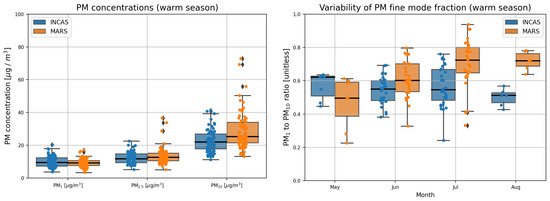
Figure 7.
Variability of , and daily averages at INCAS and MARS during May–August. 2022: PM concentrations (left panel); PM fine mode fraction (right panel).
The right panel shows the variability of the fine mode fraction at MARS and INCAS during the summer months. We observe that at INCAS the fine mode fraction is almost constant during the warm season, with a mean value around 0.55, indicating a stable predominance of small particles from traffic and industrial activity in the area, which exceeds the contribution from construction works and soil dust. At MARS, the distribution of the fine mode fraction is wider and changing from month to month. In May, the predominance of fine and coarse particles is alternated, indicating that large particles generated by the agricultural activities in the vicinity are often mixed with small particles generated by traffic and industry. From June to August, the fine mode fraction increases, with a clear bi-modal aspect in June and July, and a mono-modal aspect in August. In June-July, the circulation of air masses over Romania is influenced by the growth of the dorsal of the Azores anticyclone, which causes an advection of tropical air masses from the north of Africa [56]. Consequently, in addition to the agricultural areas in the vicinity of the MARS station, there is also a contribution from the sources of Saharan dust that is transported into the troposphere over the southeast of Romania. In August, the crops are already harvested, and the fields are burned, generating smoke particles which are generally small in size. In addition, biomass burning aerosol is transported in the troposphere from long distances (frequent and strong fires in Greece, Italy and South Romania), being partially deposited at the ground. All this adds to the traffic-related particles, increasing the fine mode fraction above the values recorded at INCAS.
Given the close proximity of the INCAS observation site to the highway exiting the capital city to the West, it is difficult to distinguish between the traffic and industry related fine particles. One way to qualitatively understand the origin of small particles at INCAS is to analyse the diurnal variation of each particulate matter fraction, which should reflect the peak traffic hours in the morning and evening. Figure 8 presents the diurnal pattern of , and at the two measurement’ sites.
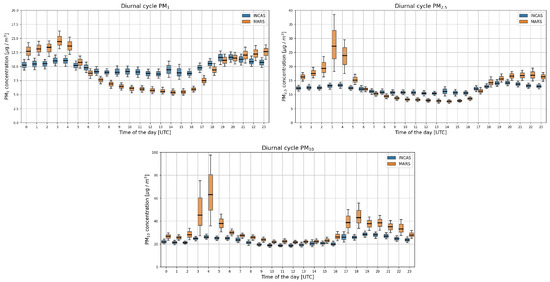
Figure 8.
Mean diurnal cycle of , , during the warm season.
We observe in general that the diurnal variation of particulate matter is much more pronounced at MARS than at INCAS. For , this is related to the daily traffic pattern where local time is CEST or UTC+3. Two peaks are highlighted in the diurnal cycle, corresponding to traffic rush hours (UTC) and decrease of the height of the planetary boundary layer. Evening peaks are broader than in the morning for both locations. A sharper peak characterises MARS location (Magurele) in the morning, while a broader one characterises INCAS location (Bucharest). MARS is located in a suburban area, the traffic being intense during the day but not so much during the night. This explains the sharper peaks. On the contrary, INCAS is located in the capital city, close to the highway, and traffic is always present. This would explain the broader diurnal cycle. However, even at INCAS traffic is reduced during the night, meaning that the flatness of the diurnal cycle cannot be explained unless a constant source of small particles is taken into consideration. There are few industrial sources in the area, most are not active at night. The only industrial source constantly burning gas to produce hot water is CET West.
In case of and diurnal cycles, these are more related to agriculture, constructions and soil dust. One can note the sharper and higher peaks at MARS, and the flatten pattern at INCAS. The more intense field work during daytime contributes to higher levels of and at MARS in the early mornings, while at INCAS the daytime peaks are flatten, being only related to constructions and soil dust. Higher values of in the afternoons at MARS are due the active winds which are frequently carrying soil dust, MARS being located in open fields and completely exposed [57]. INCAS, on the other hand, is in the city, with buildings and trees surrounding the location on three sides. Only on one side it is exposed to the road and therefore to the dust produced by constructions and lifted in the air by traffic.
3.2.2. Satellite Observations
TROPOMI retrievals were re-gridded using HARP’s AVL to a 0.01 × 0.01 degree longitude-latitude box for both warm and cold seasons considered in this study for the tropospheric nitrogen dioxide and total column carbon monoxide both in terms of (Figure 9 and Figure 10).
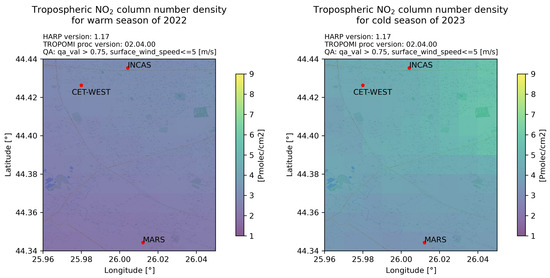
Figure 9.
Sentinel 5-P retrieval averages of tropospheric for the two seasons considered.
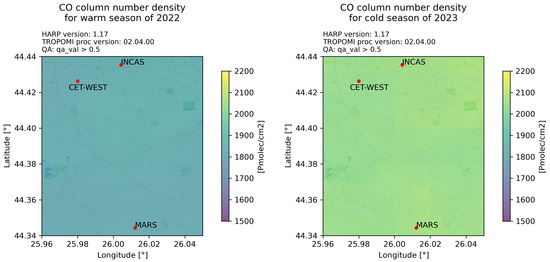
Figure 10.
Sentinel 5-P retrieval averages of total column CO for the two seasons considered.
Both and CO satellite retrievals show elevated values in the cold season indicating higher industrial activity in the cold season. A more significant difference between the two locations of MARS and INCAS is found for tropospheric nitrogen dioxide with values around 35% for the cold season. Table 4 shows the average values of all valid pixels on top of the three locations, INCAS, MARS, and CET West with the highest value for tropospheric column found for INCAS location and the highest variability for MARS location both in the winter season.

Table 4.
Mean values and associated variabilities of tropospheric column and CO densities from satellite observations (overlapping pixels) for MARS, INCAS, and CET-West locations.
3.2.3. CAMS European Air Quality Reanalyses
The CAMS European air quality reanalysis dataset provides consistent and high-quality air quality data for Europe. The dataset is based on a combination of observations and model simulations, and it provides information on a variety of air pollutants, including particulate matter ( and ), nitrogen dioxide (), and carbon monoxide (CO). The dataset is widely used for a variety of applications, including air quality assessment, health impact studies, and policy development. In this study, we have used the ENSEMBLE gridded datasets with a spatial resolution of 0.1 × 0.1 degrees with an hourly time resolution for the both warm and cold seasons and by choosing the closest pixel value at the near-surface elevation point. The closest pixel for the two locations averages are shown in Table 5. The values of PM concentrations for both 2.5 μm 10 μm as well as for NO2 and CO are double for the cold season and have larger variability. These differences can be explained by the higher industrial activity and residential heating system.

Table 5.
Mean values and associated variabilities of near-surface , , , and CO concentrations from CAMS (closest pixels) for MARS and INCAS locations.
Similar to satellite retrieval, the CAMS reanalyses related information for and CO are the highest in both warm and cold seasons for the INCAS location. The lowest average value for for the warm season is found at MARS which is consistent with the satellite retrieval and for the cold season is found at CET-West location, while for CO the lowest values for both seasons are found at CET-West. The main limitation of CAMS dataset for urban air quality analysis comes from the low spatial resolution (≈ 10×, Figure 11) of the gridded datasets. The value of the pixel can be influenced by both industry and traffic, as well as contributions from vegetation and greener areas around the city.
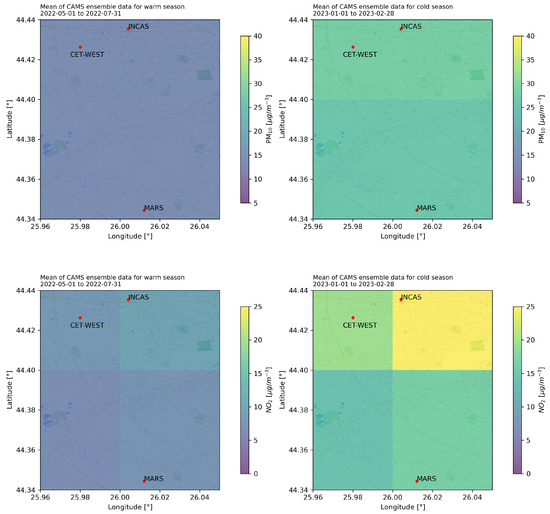
Figure 11.
CAMS European air quality reanalyses averages of and total column for the two seasons considered.
3.2.4. Fine Mapping of the Study Area
Figure 12, Figure 13 and Figure 14 depict the results for the fine mapping using the LUR model of the study area during the warm season (left panels) and the cold season (right panels).
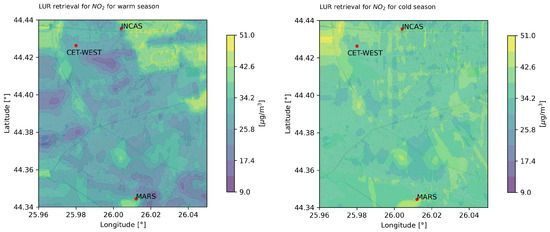
Figure 12.
LUR distribution over the Region of Interest: warm season (left panel); cold season (right panel); The location of the power plant and the two observational sites are marked in red.

Figure 13.
LUR distribution over West-Bucharest area: warm (left panel); cold (right panel).
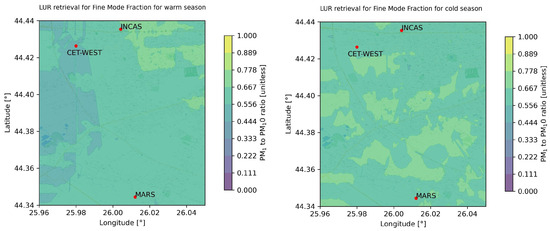
Figure 14.
LUR Fine Mode Fraction distribution over West-Bucharest area: summer (left panel); winter (right panel).
During the warm season, the hotspot appears to have a negligible impact on concentrations, as seen in Figure 12. The main cause of congestion in the region is the heavy traffic along the western city exit. During the winter season, the power plant produces higher levels of pollutants, as seen in the right panel. In addition, domestic heating also becomes significant in the region. For both warm and cold seasons, higher values are found around INCAS location which are consistent with the satellite retrieval and the modeled CAMS data.
The distribution of concentrations and the FMF ratio are more uniform across the area. (Figure 13) exhibits elevated levels throughout the cold season (right panel), while also displaying greater spatial changes during the warm season (left panel), characterized by significant values in the residential area and near the highway entrance. Elevated levels of are associated with road dust, which is generated by construction and agricultural activities, and carried by vehicles. The power plant is not located near any significant roadways and does not emit big particles. Increased planetary boundary layer height inhibits horizontal mixing [58]. In the cold season, as shown in the right panels, the distribution of is far more uniform. This occurs because of the decreased altitude of the planetary boundary layer, which facilitates the mixing of airborne particles. The entrance to the highway remains prominently apparent as a significant contributor, but the particles emitted by the narrow and congested roadways within the residential area and near the power plant are thoroughly blended and dispersed over the whole region.
During the summer season, just the urban agglomeration area have elevated values as depicted in the case of fine mode fraction (FMF) (Figure 14, left panel). FMF are commonly linked to transportation and industrial activities, but they may also be easily dispersed across long distances. As seen from Figure 14 FMF are distributed almost evenly throughout the region, including the power plant and the western part of Ilfov County (which consists of pre-urban and rural regions around the city of Bucharest). In summer (left panel), traffic and the residential area seem to be the main sources of fine particles that can be observed as a concentrated area with an FMF greater than 0.75. In winter, residential areas also stands out as a contributing source to the FMF increase due to home heating (right panel). The power plant does not appear to be a substantial contributor of fine particles, the FMF being almost similar in both seasons.
3.2.5. Typical Air Mass Circulations
To evaluate the influence of the CET West hotspot on the air quality in the western sector of Bucharest, we analysed the patterns of air mass circulation in both the lower troposphere (850 hPa) and the middle troposphere (500 hPa) using ERA5 reanalysis meteorological data provided by ECMWF (European Centre for Medium-Range Weather Forecasts).
Figure 15 illustrates the increase in wind speed throughout the summer season (left panel) and the winter season (right panel). The wind rose portrays wind speed and direction categorised into eight classes (N, NE, E, SE, S, SW, NW, and N), with a distinction between each class. Results demonstrate that, with the exception of the cold season’s circulation of air masses at high altitudes, which was mostly influenced by a circulation from the southern sector (SE-S-SW), the western region of Bucharest where the power plant is located was predominantly influenced by a circulation from the northern sector. In the low troposphere, the wind speed exhibits significant variation throughout the summer, ranging from 8 to 18 m/s, with an average of 12 m/s. In contrast, during the winter, the wind speed has a narrower range of 8 to 12 m/s, with an average of 10 m/s.
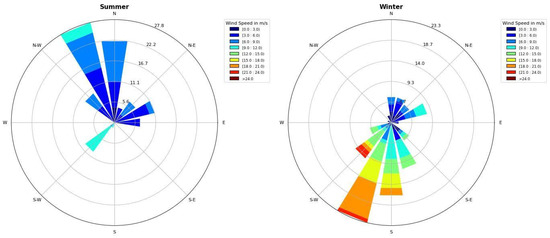
Figure 15.
Wind rose over West-Bucharest region: Summer in the left panel: pressure level at 850 hPa (up) and pressure level at 500 hPa (bottom) and winter in the right panel: pressure level at 850 hPa (up) and pressure level at 500 hPa (bottom).
The findings suggest that CET West was strategically located south-west residential areas. Insufficient wind speed would hinder the movement of contaminants, whereas at low altitudes the prevailing wind direction from north would carry the pollutants away from the inhabited regions. The transmission of pollutants from the power plant to the residential area is only favourable during winter nights when the planetary boundary layer is at a minimum and the pollutants are released above and carried by mid-tropospheric winds from the southern sector (SE-S-SW).
3.3. Summary on the Comparative Analysis
A summary of the ground-based measurements, satellite observations, and the modeled data for MARS and INCAS measurement sites are presented in Table 6 as relative differences between the temporary (INCAS) and the reference site (MARS).

Table 6.
Relative difference (INCAS versus MARS) between seasonal mean values of , , , , and CO as extracted from observations and additional data sources.
Although the different datasets give different values, we can still extract several qualitative conclusions. Considering all uncertainty factors, MARS and INCAS are similar in terms of and during the warm season, while values at MARS are higher. From the perspective of particulate matter, INCAS does not seem to be impacted by the operations of the CET West, at least it is impossible to separate it from other sources. MARS location is constantly impacted by the agriculture activities in the vicinity, the effect being amplified by the winds (as can be observed in Figure 12). For the cold season the only available dataset is from low-cost sensors. Based on this data, INCAS location seems to be exposed to higher values which can be attributed to CET West operations up to a certain degree. The near surface concentrations are higher at INCAS than at MARS regardless of the season, observations being confirmed by the CAMS reanalyses and from satellite retrieval. This result can only be partially explained by the more intense traffic at INCAS.
4. Conclusions
This study presents our results on the possible detrimental impact of the CET West on the population residing in the residential region located northeast of the power station. The western district of Bucharest, which is the focus of our study, is a complex location characterised by several significant pollution sources, including construction, industry, transportation, and even agriculture. Therefore, it is not entirely feasible to separate the effects of the power plant from other sources for two main reasons: (a) measurements and models that rely on measurements include contributions from all sources, making it difficult to quantitatively distinguish between them; (b) publicly available emission inventories for Bucharest are unreliable, as they consistently underestimate traffic, leading to unrealistic results when using inventory-based models. We chose to conduct our investigation mostly through observations.
This study demonstrates the innovative approach of integrating near-surface observations, satellite data from TROPOMI, and European reanalysis data from the CAMS to comprehensively assess the impact of the CET Vest power plant on urban air quality in Bucharest, Romania, providing a multi-faceted understanding beyond traditional single-source analyses by combining data from satellite, ground based, modeling, and reanalysis. This study and its results provide a robust, data-driven assessment of the CET Vest power plant’s impact on urban air quality, offering concrete evidence that can inform policy decisions regarding industrial emissions regulations and urban planning strategies in Bucharest and can serve as good example in other European cities facing comparable challenges.
According to the investigation conducted, it has been determined that the CET West power plant does not have a significant impact on the air quality in the surrounding residential areas, therefore contradicting our first predictions. The sole pollutant that can be attributed to the power plant as a source is , mostly during the winter season (please note that high resolution measurements of and CO were not accessible for this research). Due to its high reactivity, is eliminated prior to its transportation to residential areas, therefore only impacting the immediate vicinity of the power plant.
CET West does not contribute significantly to the inmission of particles, including FMF. Elevated levels of and have been detected in close proximity to the power plant, however the disparities compared to other areas are not significant enough to definitively pinpoint the origin. The presence of road dust, generated by agricultural and construction activities and carried by traffic, consistently masks the impact of the power plant to some extent. The bigger discrepancies seen in comparison to other districts throughout the cold season may suggest that the power plant consistently emits particles into the neighbourhood (with increased activities during winter). Nevertheless, the presence of CET West does not imply that individuals residing northeast of it are impacted.
The regime of low wind levels at CET West hinders the movement of contaminants which remain in the proximity of the power plant. Moreover, at low altitudes, prevailing wind directions from the northern sector carry the pollutants away from the city. The transmission of pollutants from the power plant to the residential area is only favourable during winter nights when the planetary boundary layer is at a minimum and the pollutants are released above and carried by mid-tropospheric winds from the southern sector (SE-S-SW).
Author Contributions
Conceptualization, D.N. and C.T.; methodology, C.T. and A.M.D.; software, C.T. and A.V.D.; validation, A.M.D. and A.I.; formal analysis, D.N., C.T., J.V., A.M.D., L.B., S.M.N. and G.C.; investigation, J.V., A.I., A.V.D., G.C. and O.G.T.; resources, O.G.T.; data curation, D.N., L.B., A.M.D. and J.V.; writing—original draft preparation, D.N., C.T., J.V., A.I. and A.V.D.; writing—review and editing, D.N., C.T., J.V., A.M.D., L.B., A.N., F.T., A.I., A.V.D., S.M.N., G.C. and V.V.; visualization, A.M.D. and S.M.N.; supervision, D.N., J.V. and A.M.D.; project administration, D.N.; funding acquisition, V.V. All authors have read and agreed to the published version of the manuscript.
Funding
This work was carried out through RI-URBANS project (Research Infrastructures Services Reinforcing Air Quality Monitoring Capacities in European Urban & Industrial Areas), European Union’s Horizon 2020 research and innovation program under grant agreement, contract 101036245. Part of the work was funded by the Core Program within the National Research Development and Innovation Plan 2022–2027, with the support of MCID, project no. PN23 05/3.01.2023 and by the European Union’s Horizon 2020 research and innovation programme through the ATMO-ACCESS Integrating Activity under grant agreement No 101008004. The research was partially funded by the European Regional Development Fund through the Competitiveness Operational Programme 2014–2020, POC-A.1-A.1.1.1-F-2015, project Research Centre for Environment and Earth Observation CEO-Terra, SMIS code 108109, contract No. 152/2016.
Institutional Review Board Statement
Not applicable.
Informed Consent Statement
Not applicable.
Data Availability Statement
The datasets analysed during the current study are available in the following repositories: CAMS ENSAMBLE, Institut national de l’environnement industriel et des risques (INERIS), Aarhus University, Norwegian Meteorological Institute (MET Norway), Jülich Institut für Energie- und Klimaforschung (IEK), Institute of Environmental Protection–National Research Institute (IEP-NRI), Koninklijk Nederlands Meteorologisch Instituut (KNMI), METEO FRANCE, Nederlandse Organisatie voor toegepast-natuurwetenschappelijk onderzoek (TNO), Swedish Meteorological and Hydrological Institute (SMHI), Finnish Meteorological Institute (FMI), Italian National Agency for New Technologies, Energy and Sustainable Economic Development (ENEA) and Barcelona Supercomputing Center (BSC) (2022): CAMS European air quality forecasts, ENSEMBLE data. Copernicus Atmosphere Monitoring Service (CAMS) Atmosphere Data Store (ADS). (Accessed on 25 April 2024), https://ads.atmosphere.copernicus.eu/datasets/cams-europe-air-quality-reanalyses?tab=overview. C3S ERA5, Copernicus Climate Change Service (2022): ERA5-Land hourly data from 1950 to present. Copernicus Climate Change Service (C3S) Climate Data Store (CDS), DOI: 10.24381/cds.e2161bac (Accessed on 25 February 2024). TROPOMI NO2, Copernicus Sentinel-5P (processed by ESA), 2018, TROPOMI Level 2 Nitrogen Dioxide total column products. Version 01. European Space Agency. https://doi.org/10.5270/S5P-s4ljg54. TROPOMI CO, Copernicus Sentinel-5P (processed by ESA), 2021, TROPOMI Level 2 Carbon Monoxide total column products. Version 02. European Space Agency. https://doi.org/10.5270/S5P-bj3nry0. Ground based low cost sensor datasets generated during the current study are not publicly available but are available from the corresponding authors on reasonable request.
Acknowledgments
We gratefully acknowledge the National Air Quality Monitoring Network (RNMCA), part of the Ministry of Environment, for providing air quality data used for model evaluation. Also, we thank INCAS for hosting the temporary site and making available the Ecomesure EcomTrek instrument and BOKU-Met, Vienna, Austria for facilitating access to the supercomputer from the IT infrastructure used for the LUR models. This publication has been prepared using European Union’s Copernicus Land Monitoring Service, Copernicus Atmosphere Monitoring Service, and Copernicus Climate Change Service information [2024].
Conflicts of Interest
The authors declare no conflicts of interest.
References
- Quevauviller, P. A Review on Connecting Research, Policies and Networking in the Area of Climate-Related Extreme Events in the EU with Highlights of French Case Studies. Atmosphere 2022, 13, 117. [Google Scholar] [CrossRef]
- Nahorski, Z.; Holnicki, P.; Kałuszko, A. Towards Air Quality Protection in an Urban Area—Case Study. Atmosphere 2024, 15, 1106. [Google Scholar] [CrossRef]
- Hou, L.; Zhang, B. The Positive Effects of Linked Control Policy for Vessels Passing Through Locks on Air Quality—A Case Study of Yichang, China. Atmosphere 2025, 16, 368. [Google Scholar] [CrossRef]
- Alves Laucas e Myrrha, L.H.; Loukili, Y.F.C.; Silveira, G.d.O.; Tavella, R.A.; Bonifácio, A.d.S.; Brum, R.d.L.; Pereira, N.; da Silva Júnior, F.M.R. Health and Economic Benefits of Accelerating the PM10 Interim Targets in Brazil’s New Air Quality Resolution: A Case Study in Southern Brazil. Atmosphere 2025, 16, 270. [Google Scholar] [CrossRef]
- European Environment Agency (EEA). Health Impacts of Air Pollution in Europe. 2024. Available online: https://www.eea.europa.eu//publications/europes-air-quality-status-2024 (accessed on 23 April 2025).
- Shahrokhishahraki, N.; Rayner, P.; Silver, J.; Thomas, S.; Schofield, R. High-resolution modeling of gaseous air pollutants over Tehran and validation with surface and satellite data. Atmos. Environ. 2021, 270, 118881. [Google Scholar] [CrossRef]
- Wang, Y.; Ma, Y.F.; Muñoz-Esparza, D.; Dai, J.; Li, C.W.Y.; Lichtig, P.; Tsang, R.C.W.; Liu, C.H.; Wang, T.; Brasseur, G.P. Coupled mesoscale–microscale modeling of air quality in a polluted city using WRF-LES-Chem. Atmos. Chem. Phys. 2023, 23, 5905–5927. [Google Scholar] [CrossRef]
- Lin, C.; Wang, Y.; Ooka, R.; Flageul, C.; Kim, Y.; Kikumoto, H.; Wang, Z.; Sartelet, K. Modeling of street-scale pollutant dispersion by coupled simulation of chemical reaction, aerosol dynamics, and CFD. Atmos. Chem. Phys. 2023, 23, 1421–1436. [Google Scholar] [CrossRef]
- Jin, Y.; Sharifi, A. Machine learning for predicting urban greenhouse gas emissions: A systematic literature review. Renew. Sustain. Energy Rev. 2025, 215, 115625. [Google Scholar] [CrossRef]
- Douros, J.; Eskes, H.; van Geffen, J.; Boersma, K.; Compernolle, S.; Pinardi, G.; Blechschmidt, A.M.; Peuch, V.H.; Colette, A.; Veefkind, P. Comparing Sentinel-5P TROPOMI NO2 column observations with the CAMS regional air quality ensemble. Geosci. Model Dev. 2023, 16, 509–534. [Google Scholar] [CrossRef]
- Baldasano, J.; Pay, M.; Jorba, O.; Gassó, S.; Jimenez-Guerrero, P. An annual assessment of air quality with the CALIOPE modeling system over Spain. Sci. Total Environ. 2011, 409, 2163–2178. [Google Scholar] [CrossRef]
- Benavides, J. Development and Evaluation of a Street-Scale Air Quality Modelling System for the City of Barcelona. Ph.D. Thesis, Universitat Politècnica de Catalunya, Barcelona, Spain, 2020. [Google Scholar]
- Lugon, L.; Sartelet, K.; Kim, Y.; Vigneron, J.; Chretien, O. Simulation of primary and secondary particles in the streets of Paris using MUNICH. Faraday Discuss. 2020, 226, 432–456. [Google Scholar] [CrossRef] [PubMed]
- Sartelet, K.; Kim, Y.; Couvidat, F.; Merkel, M.; Petäjä, T.; Sciare, J.; Wiedensohler, A. Influence of emission size distribution and nucleation on number concentrations over Greater Paris. Atmos. Chem. Phys. 2022, 22, 8579–8596. [Google Scholar] [CrossRef]
- Tack, F.; Merlaud, A.; Iordache, M.D.; Pinardi, G.; Dimitropoulou, E.; Eskes, H.; Bomans, B.; Veefkind, P.; Van Roozendael, M. Assessment of the TROPOMI tropospheric NO2 product based on airborne APEX observations. Atmos. Meas. Tech. Discuss. 2020, 2020, 615–646. [Google Scholar] [CrossRef]
- Verhoelst, T.; Compernolle, S.; Pinardi, G.; Lambert, J.C.; Eskes, H.; Eichmann, K.U.; Fjaeraa, A.M.; Granville, J.; Niemeijer, S.; Cede, A.; et al. Ground-based validation of the Copernicus Sentinel-5P TROPOMI NO2 measurements with the NDACC ZSL-DOAS, MAX-DOAS and Pandonia global networks. Atmos. Meas. Tech. 2021, 14, 481–510. [Google Scholar] [CrossRef]
- Langen, J.; Meijer, Y.; Brinksma, E.; Veihelmann, B.; Ingmann, P. Copernicus Sentinels 4 and 5 Mission Requirements Traceability Document (MRTD), ESA; Technical Report, EO-SMA-/1507/JL; ESA: Paris, France, 2017; Available online: https://sentinel.esa.int/documents/247904/2506504/Copernicus-Sentinels-4-and-5-Mission-Requirements-Traceability-Document.pdf (accessed on 21 April 2024).
- Buonocore, J.; Dong, X.; Spengler, J.; Fu, J.; Levy, J. Using the Community Multiscale Air Quality (CMAQ) model to estimate public health impacts of PM2.5 from individual power plants. Environ. Int. 2014, 68C, 200–208. [Google Scholar] [CrossRef]
- Cichowicz, R.; Dobrzański, M. Modeling Pollutant Emissions: Influence of Two Heat and Power Plants on Urban Air Quality. Energies 2021, 14, 5218. [Google Scholar] [CrossRef]
- Gao, M.; Beig, G.; Song, S.; Zhang, H.; Hu, J.; Ying, Q.; Liang, F.; Liu, Y.; Wang, H.; Lu, X.; et al. The impact of power generation emissions on ambient PM2.5 pollution and human health in China and India. Environ. Int. 2018, 121, 250–259. [Google Scholar] [CrossRef]
- Kerckhoffs, J.; Khan, J.; Hoek, G.; Yuan, Z.; Ellermann, T.; Hertel, O.; Ketzel, M.; Jensen, S.; Meliefste, K.; Vermeulen, R. Mixed-Effects Modeling Framework for Amsterdam and Copenhagen for Outdoor NO2 Concentrations Using Measurements Sampled with Google Street View Cars. Environ. Sci. Technol. 2022, 56, 7174–7184. [Google Scholar] [CrossRef] [PubMed]
- Menut, L.; Bessagnet, B.; Briant, R.; Cholakian, A.; Couvidat, F.; Mailler, S.; Pennel, R.; Siour, G.; Tuccella, P.; Turquety, S.; et al. The CHIMERE v2020r1 online chemistry-transport model. Geosci. Model Dev. 2021, 14, 6781–6811. [Google Scholar] [CrossRef]
- Raducan, G.; Stefan, S. Characterization of traffic-generated pollutants in Bucharest. Atmósfera 2009, 22, 99–110. [Google Scholar]
- Kim, Y.; Lugon, L.; Maison, A.; Sarica, T.; Roustan, Y.; Valari, M.; Zhang, Y.; Andre, M.; Sartelet, K. MUNICH v2.0: A street-network model coupled with SSH-aerosol (v1.2) for multi-pollutant modelling. Geosci. Model Dev. 2022, 15, 7371–7396. [Google Scholar] [CrossRef]
- Mölter, A.; Lindley, S. Developing land use regression models for environmental science research using the XLUR tool–More than a one-trick pony. Environ. Model. Softw. 2021, 143, 105108. [Google Scholar] [CrossRef]
- Chen, L.; Shi, L. Differences in urban–rural gradient and driving factors of PM2.5 concentration in the Zhengzhou Metropolitan Area. Air Qual. Atmos. Health 2024, 17, 2187–2201. [Google Scholar] [CrossRef]
- Wan, Y.; Yuan, L.; Xu, X. Adopting urban morphological indicators to land use regression modeling of seasonal mean PM2.5 concentrations for a high-density city. Air Qual. Atmos. Health 2022, 15, 559–573. [Google Scholar] [CrossRef]
- Hoek, G. Methods for Assessing Long-Term Exposures to Outdoor Air Pollutants. Curr. Environ. Health Rep. 2017, 4, 450–462. [Google Scholar] [CrossRef] [PubMed]
- Lugon, L.; Vigneron, J.; Debert, C.; Chrétien, O.; Sartelet, K. Black carbon modeling in urban areas: Investigating the influence of resuspension and non-exhaust emissions in streets using the Street-in-Grid model for inert particles (SinG-inert). Geosci. Model Dev. 2021, 14, 7001–7019. [Google Scholar] [CrossRef]
- National Institute of Statistics (INSSE). Populatia. Available online: https://bucuresti.insse.ro/ (accessed on 11 June 2024).
- Ilie, A.; Vasilescu, J.; Talianu, C.; Ioja, C.; Nemuc, A. Spatiotemporal Variability of Urban Air Pollution in Bucharest City. Atmosphere 2023, 14, 1759. [Google Scholar] [CrossRef]
- Tomtom. Traffic Index Ranking. Available online: https://www.tomtom.com/traffic-index/ranking/ (accessed on 11 June 2024).
- National Institute of Statistics (INSSE). Inmatriculari. Available online: https://insse.ro/cms/ro/tags/comunicat-inmatriculari-noi-de-vehicule-rutiere (accessed on 11 June 2024).
- National Air Quality Monitoring Network (NAQMN). SEVESO. Available online: https://www.anpm.ro/ro/managementul-riscului-seveso (accessed on 8 February 2024).
- Primaria Bucuresti. Proiecte in Executie. Available online: https://www.pmb.ro/interes-public/menu-page (accessed on 19 June 2024).
- Santiere Online. Proiecte. Available online: https://www.santiereonline.ro/app/projects (accessed on 19 June 2024).
- Guevara, M. Emissions of Primary Particulate Matter; The Royal Society of Chemistry: Cambridge, UK, 2016; Volume 2016, pp. 1–34. [Google Scholar] [CrossRef]
- Tomlin, A.S. Air quality and climate impacts of biomass use as an energy source: A review. Energy Fuels 2021, 35, 14213–14240. [Google Scholar] [CrossRef]
- Ministry of Regional Development and Public Administration; Ministry of Energy. Report on the Assessment of the National Potential to Implement High-Efficiency Cogeneration and Efficient District Heating and Cooling; Technical Report; Ministry of Regional Development and Public Administration; Ministry of Energy: 2015. Available online: https://energy.ec.europa.eu/system/files/2016-07/RO%25202016%2520Energy%2520Efficiency%2520Annual%2520Report_en_0.pdf (accessed on 21 April 2024).
- ELCEN. Electrocentrale Bucureşti. Available online: https://www.elcen.ro/ (accessed on 8 February 2024).
- ECMWF. Copernicus Atmosphere Monitoring Service, ENSEMBLE Dataset. 2021. Available online: https://ads.atmosphere.copernicus.eu/doi/10.24381/7cc0465a (accessed on 10 June 2024).
- European Standard CEN EN 12341; Ambient Air—Standard Gravimetric Measurement Method for the Determination of the PM10 or PM2.5 Mass Concentration of Suspended Particulate Matter. Available online: https://standards.iteh.ai/catalog/standards/sist/4794d8f6-b5b1-43b7-9e95-7a7f2410b5ca/sist-en-12341-2023 (accessed on 10 June 2024).
- European Standard CEN EN 17660; Air Quality—Performance Evaluation of Air Quality Sensor Systems. Available online: https://standards.iteh.ai/catalog/standards/sist/45202731-4088-40a1-b2d4-12b9542fb1a4/sist-ts-cen-ts-17660-2-2025 (accessed on 10 June 2024).
- Chacon Mateos, M.; Laquai, B.; Vogt, U.; Stubenrauch, C. Evaluation of a low-cost dryer for a low-cost optical particle counter. Atmos. Meas. Tech. 2022, 15, 7395–7410. [Google Scholar] [CrossRef]
- Sartelet, K.; Kerckhoffs, J.; Athanasopoulou, E.; Lugon, L.; Vasilescu, J.; Zhong, J.; Hoek, G.; Joly, C.; Park, S.J.; Talianu, C.; et al. Air pollution mapping and variability over five European cities. Environ. Int. 2025, 199, 109474. [Google Scholar] [CrossRef]
- Talianu, C.; Vasilescu, J.; Nicolae, D.; Ilie, A.; Dandocsi, A.; Nemuc, A.; Belegante, L. High-resolution air quality maps for Bucharest using Mixed-Effects Modeling Framework. Atmos. Chem. Phys. 2025, 2025, 4639–4654. [Google Scholar] [CrossRef]
- ECOMESURE. EcomTrek technical specifications, 2024. Available online: https://ecomesure.com/PDF/fiches-produits/ECOMTREK-VEN.pdf (accessed on 10 June 2024).
- ESA. TROPOMI Level 2 Nitrogen Dioxide; European Space Agency: Paris, France, 2021. [Google Scholar] [CrossRef]
- ESA. TROPOMI Level 2 Carbon Monoxide Total Column; European Space Agency: Paris, France, 2021. [Google Scholar] [CrossRef]
- Tayebi, S.; Kerckhoffs, J.; Khan, J.; de Hoogh, K.; Chen, J.; Taghavi-Shahri, S.M.; Bergmann, M.L.; Cole-Hunter, T.; Lim, Y.H.; Mortensen, L.H.; et al. Comparison of NO2 and BC Predictions Estimated Using Google Street View-Based and Conventional European-Wide LUR Models in Copenhagen, Denmark. Atmosphere 2023, 14, 1602. [Google Scholar] [CrossRef]
- UNIVERSITEIT UTRECHT. European Study of Cohorts for Air Pollution Effects. Available online: https://cordis.europa.eu/project/id/211250 (accessed on 19 June 2024).
- National Air Quality Monitoring Network (NAQMN). Calitatea Aerului. Available online: https://www.calitateaer.ro/public/home-page/?__locale=ro (accessed on 8 February 2024).
- Lu, J.; Zhang, Y.; Chen, M.; Wang, L.; Zhao, S.; Pu, X.; Chen, X. Estimation of monthly 1 km resolution PM2.5 concentrations using a random forest model over “2 + 26” cities, China. Urban Clim. 2021, 35, 100734. [Google Scholar] [CrossRef]
- OpenStreetMap. OpenStreetMap Database [PostgreSQL via API]; OpenStreetMap Foundation: Cambridge, UK, 2021; Available online: https://www.openstreetmap.org (accessed on 19 June 2024).
- European Environment Agency (EEA). Health Impacts of Air Pollution in Europe. 2022. Available online: https://www.eea.europa.eu/publications/air-quality-in-europe-2022/health-impacts-of-air-pollution (accessed on 19 April 2024).
- Romanian National Meteorological Agency (RNMA). Caracterizări Climatologice Multianuale. Available online: https://www.meteoromania.ro/clim/caracterizare-multianuala/index.html (accessed on 19 June 2024).
- Pirloaga, R.; Adam, M.; Antonescu, B.; Andrei, S.; Stefan, S. Ground-Based Measurements of Wind and Turbulence at Bucharest–Măgurele: First Results. Remote Sens. 2023, 15, 1514. [Google Scholar] [CrossRef]
- Seinfeld, J.H.; Pandis, S.N. Atmospheric Chemistry and Physics: From Air Pollution to Climate Change; John Wiley & Sons: Hoboken, NJ, USA, 2016; ISBN 978-1-118-94740-1. [Google Scholar]
Disclaimer/Publisher’s Note: The statements, opinions and data contained in all publications are solely those of the individual author(s) and contributor(s) and not of MDPI and/or the editor(s). MDPI and/or the editor(s) disclaim responsibility for any injury to people or property resulting from any ideas, methods, instructions or products referred to in the content. |
© 2025 by the authors. Licensee MDPI, Basel, Switzerland. This article is an open access article distributed under the terms and conditions of the Creative Commons Attribution (CC BY) license (https://creativecommons.org/licenses/by/4.0/).